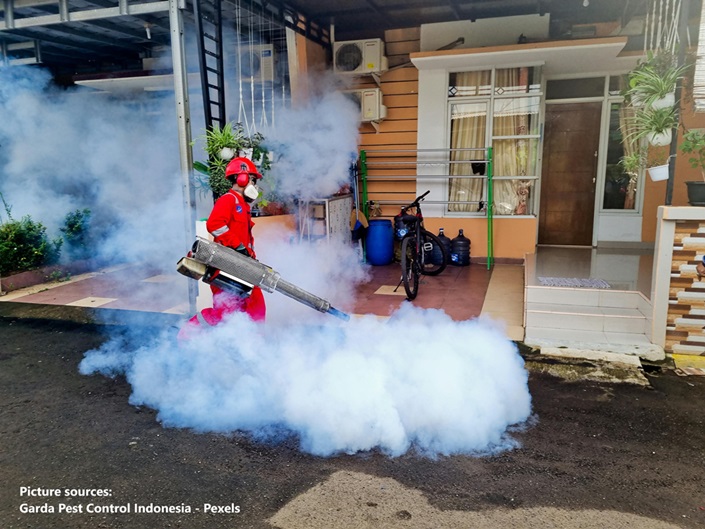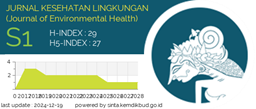Implementation of Insecticide for Fogging and Larvicidation in Dengue Fever Control and Its Impact on Vector Resistance in Banjarmasin City: A Qualitative Analysis

Introduction: Dengue remains a major public health concern in Indonesia, including Banjarmasin. Insecticide-based interventions, such as fogging and larviciding, are key components of dengue vector control. However, improper implementation can lead to insecticide resistance, reducing program effectiveness. Methods: This qualitative study aimed to evaluate the implementation of insecticide use in the dengue control program in Banjarmasin. Data were collected through in-depth interviews, observations, and document reviews at national, provincial, and municipal levels. A total of 60 informants were purposively selected, including stakeholders from the Ministry of Health, provincial and city health offices, pharmaceutical warehouses, community health centers, sub-districts, and urban villages. Data were analyzed using a deductive Input-Process-Output (IPO) model and inductive gap analysis. Triangulation was applied to ensure data validity. Results and Discussion: The study revealed that the absence of national and local insecticide resistance mapping hinders the implementation of insecticide rotation policies. Other challenges include a shortage of trained entomology personnel, limited training, weak intersectoral coordination, and poor dissemination of vector control regulations, particularly regarding fogging procedures. Moreover, unsupervised community-led fogging often deviates from standard operating procedures. Conclusion: Strengthening human resource capacity, improving insecticide distribution planning based on resistance data, and enhancing regulatory enforcement are critical to improving program effectiveness. Promoting community-based approaches is also essential to support sustainable and responsive dengue vector control strategies.
Arham AF, Amin L, Mustapa MAC, Mahadi Z, Yaacob M, Wasli MMP, et al. Fogging to Combat Dengue: Factors Influencing Stakeholders’ Attitudes in Malaysia. BMC Public Health. 2023;23(1140):1-13. https://doi.org/10.1186/s12889-023-16054-3
Ritchie SA, Devine GJ, Vazquez-Prokopec GM, Lenhart AE, Manrique-Saide P, Scott TW. Insecticide-Based Approaches for Dengue Vector Control. In: Ecology and Control of Vector-borne Diseases. Leiden: Wageningen Academic Publishers; 2021. p. 380-390. https://doi.org/10.3920/978-90-8686-895-7_4
Wilke ABB, Vasquez C, Carvajal A, Ramirez M, Cardenas G, Petrie WD, et al. Effectiveness of Adulticide and Larvicide in Controlling High Densities of Aedes aegypti in Urban Environments. PLoS One. 2021;16(11):1-15. https://doi.org/10.1371/journal.pone.0246046
Arham AF, Amin L, Mustapa MAC, Mahadi Z, Yaacob M, Ibrahim M. Stakeholders’ Attitudes to Outdoor Residual Spraying Technique for Dengue Control in Malaysia: A PLS-SEM Approach. PLoS Negl Trop Dis. 2021;15(6):1-16. https://doi.org/10.1371/journal.pntd.0009493
Wellekens K, Betrains A, De Munter P, Peetermans W. Dengue: Current State One Year Before WHO 2010--2020 Goals. Acta Clin Belg. 2022;77(2):436-444. https://doi.org/10.1080/17843286.2020.1837576
Paz-Bailey G, Adams LE, Deen J, Anderson KB, Katzelnick LC. Dengue. Lancet. 2024;403(10427):667-682. https://doi.org/10.1016/S0140-6736(23)02576-X
Ridha MR, Marlinae L, Zubaidah T, Fadillah NA, Widjaja J, Rosadi D, et al. Control Methods for Invasive Mosquitoes of Aedes aegypti and Aedes albopictus (Diptera: Culicidae) in Indonesia. Vet World. 2023;16(9):1952-1963. https://doi.org/10.14202/vetworld.2023.1952-1963
Juhairiyah, Ridha MR, Ferdina AR, Rahayu N, Tazkiah M, Others. Supporting and Inhibiting Factors of Implementation of Dengue Control in East Kalimantan: A Qualitative Study. Malaysian J Med & Heal Sci. 2024;20(SUPP9):186-194. https://www.medic.upm.edu.my/upload/dokumen/2024111108514531_MJMHS_0753.pdf
Deng J, Huang S, Wang L, Deng W, Yang T. Conceptual Framework for Smart Health: A multi-Dimensional Model using IPO Logic to Link Drivers and Outcomes. Int J Environ Res Public Health. 2022;19(16742):1-22. https://doi.org/10.3390/ijerph192416742
Sulistyawati S, Sofiana L, Amala SK, Rokhmayanti R, Astuti FD, Nurfita D. Pneumonia a Neglected Disease: A Mixed-Method Study on The Case-Finding Program in Indonesia. AIMS Public Heal. 2020;7(1):81-91. https://doi.org/10.3934/publichealth.2020008
Bugin K, Lotrecchiano GR, O’Rourke M, Butler J. Evaluating Integration in Collaborative Cross-Disciplinary FDA New Drug Reviews Using an Input-Process-Output Model. J Clin Transl Sci. 2021;5(e199):1-10. https://doi.org/10.1017/cts.2021.861
Leandro A, Maciel-de-Freitas R. Development of an Integrated Surveillance System to Improve Preparedness for Arbovirus Outbreaks in a Dengue Endemic Setting: Descriptive Study. JMIR Public Heal Surveill. 2024;10(e62759):1-14. https://doi.org/10.2196/62759
Nikbakht E, Sarkar S, Smith GC, Spieler AC. Pre-IPO earnings management: Evidence from India. J Int Accounting Audit Tax. 2021;44(100400):1-21 https://doi.org/10.1016/j.intaccaudtax.2021.100400
Siddiqui JA, Fan R, Naz H, Bamisile BS, Hafeez M, Ghani MI, et al. Insights Into Insecticide-Resistance Mechanisms in Invasive Species: Challenges and Control Strategies. Front Physiol. 2022;13(1):1-8. https://doi.org/10.3389/fphys.2022.1112278
Onstad DW, Knolhoff LM. Insect Resistance Management: Biology, Economics, and Prediction. Third Edit. Cambridge: Academic Press; 2022. https://doi.org/10.1016/C2020-0-00002-2
Soderlund DM. Neurotoxicology of Pyrethroid Insecticides. Advances in Neurotoxicology. 2020;4(1):113-165. https://doi.org/10.1016/bs.ant.2019.11.002
Tang T, Wu R, Zhang L, Wang Y, Ling J, Du W, et al. Distribution and Partitioning of Pyrethroid Insecticides in Agricultural Lands: Critical Influencing Factors. Environ Int. 2021;156(106736):1-9. https://doi.org/10.1016/j.envint.2021.106736
Zhu Q, Yang Y, Zhong Y, Lao Z, O-Neill P, Hong D, et al. Synthesis, Insecticidal Activity, Resistance, Photodegradation and Toxicity of Pyrethroids (A Review). Chemosphere. 2020;254(126779):1-17. https://doi.org/10.1016/j.chemosphere.2020.126779
Bhatt P, Bhatt K, Huang Y, Lin Z, Chen S. Esterase is a Powerful Tool for The Biodegradation of Pyrethroid Insecticides. Chemosphere. 2020;244(125507):1-54. https://doi.org/10.1016/j.chemosphere.2019.125507
Méjanelle L, Jara B, Dachs J. Fate of Pyrethroids in Freshwater and Marine Environments. In: Pyrethroid Insecticides The Handbook of Environmental Chemistry. Cham: Springer; 2020. p. 81-107. https://doi.org/10.1007/698_2019_433
Zhang W, Yang F, Zhang Y, Zhou K. Simultaneous Determination of Seven Carbamate Pesticide Residues in Vegetable by Capillary Electrophoresis with Solid Phase Microextraction. Int J Electrochem Sci. 2021;16(6):1-14. https://doi.org/10.20964/2021.06.06
Mulla SI, Ameen F, Talwar MP, Eqani SAMAS, Bharagava RN, Saxena G, et al. Organophosphate Pesticides: Impact on Environment, Toxicity, and their Degradation. In: Bioremediation of Industrial Waste for Environmental Safety: Volume I: Industrial Waste and Its Management. Cham: Springer; 2020. p. 265-290. https://doi.org/10.1007/978-981-13-1891-7
Mdeni NL, Adeniji AO, Okoh AI, Okoh OO. Analytical Evaluation of Carbamate and Organophosphate Pesticides in Human and Environmental Matrices: a Review. Molecules. 2022;27(618):1-21. https://doi.org/10.3390/molecules27030618
Mali H, Shah C, Raghunandan BH, Prajapati AS, Patel DH, Trivedi U, et al. Organophosphate Pesticides an Emerging Environmental Contaminant: Pollution, Toxicity, Bioremediation Progress, and Remaining Challenges. J Environ Sci. 2023;127(1):234-250. https://doi.org/10.1016/j.jes.2022.04.023
Kaushal J, Khatri M, Arya SK. A Treatise on Organophosphate Pesticide Pollution: Current Strategies and Advancements in Their Environmental Degradation and Elimination. Ecotoxicol Environ Saf. 2021;207(111483):1-12. https://doi.org/10.1016/j.ecoenv.2020.111483
Pu J, Wang Z, Chung H. Climate Change and The Genetics of Insecticide Resistance. Pest Manag Sci. 2020;76(3):846-852. https://doi.org/10.1002/ps.5700
Sparks TC, Crossthwaite AJ, Nauen R, Banba S, Cordova D, Earley F, et al. Insecticides, Biologics and Nematicides: Updates to IRAC’s Mode of Action Classification - a Tool for Resistance Management. Pestic Biochem Physiol. 2020;167(104587):1-10. https://doi.org/10.1016/j.pestbp.2020.104587
Hamid NA, Noor SNM, Saadatian-Elahi M, Isa NR, Rodzay RM, Ruslan BM, et al. Residual Spray for the Control of Aedes Vectors in Dengue Outbreak Residential Areas. Adv Entomol. 2019;07(04):105-123. https://doi.org/10.4236/ae.2019.74009
Wang Q, Luo C, Wang R. Insecticide Resistance and Its Management in Two Invasive Cryptic Species of Bemisia Tabaci in China. Int J Mol Sci. 2023;24(6048):1-12. https://doi.org/10.3390/ijms24076048
Dusfour I, Vontas J, David JP, Weetman D, Fonseca DM, Corbel V, et al. Management of Insecticide Resistance in The Major Aedes Vectors of Arboviruses: Advances and Challenges. PLoS Negl Trop Dis. 2019;13(10):1-22. https://doi.org/10.1371/journal.pntd.0007615
Van den Berg H, da Silva Bezerra HS, Chanda E, Al-Eryani S, Nagpal BN, Gasimov E, et al. Management of Insecticides for use in Disease Vector Control: a Global Survey. BMC Infect Dis. 2021;21(1):1-10. https://doi.org/10.1186/s12879-021-06155-y
Selvarajoo S, Liew JWK, Tan W, Lim XY, Refai WF, Zaki RA, et al. Knowledge, Attitude and Practice on Dengue Prevention and Dengue Seroprevalence in a Dengue Hotspot in Malaysia: A cross-Sectional Study. Sci Rep. 2020;10(1):1-13. https://doi.org/10.1038/s41598-020-66212-5
Ramli NM, Mohd Yatim SR, Dom NC, Zaki MA, Abdullah S. A Household-Based Survey of Knowledge, Attitudes and Practices Towards Dengue Fever Among Local Urban Communities: a Case Study in PPR Batu Muda, Kuala Lumpur. Malaysian J Med Heal Sci. 2022;18(8):202-210. https://medic.upm.edu.my/upload/dokumen/2022070111262027_0128.pdf
Barrera R. Recommendations for the Surveillance of Aedes aegypti. Biomed HHS Public Access. 2019;36(3):454-462. https://doi.org/10.7705/biomedica.v36i3.2892
Buhler C, Winkler V, Runge-Ranzinger S, Boyce R, Horstick O. Environmental Methods for Dengue Vector Control – A Systematic Review and Meta-Analysis. PLoS Negl Trop Dis. 2019;13(7):1-15. https://doi.org/10.1371/journal.pntd.0007420
Dambach P, Louis VR, Standley CJ, Montenegro-Quiñonez CA. Beyond Top-Down: Community Co-Creation Approaches for Sustainable Dengue Vector Control. Glob Health Action. 2024;17(2426348):1-10. https://doi.org/10.1080/16549716.2024.2426348
Edillo F, Ymbong RR, Bolneo AA, Hernandez RJ, Fuentes BL, Cortes G, et al. Temperature, Season, and Latitude Influence Development-Related Phenotypes of Philippine Aedes aegypti (Linnaeus): Implications for Dengue Control Amidst Global Warming. Parasites and Vectors. 2022;15(1):1-17. https://doi.org/10.1186/s13071-022-05186-x
Al Basir F, Chowdhury J, Torres DFM. Dynamics of a Double-Impulsive Control Model of Integrated Pest Management Using Perturbation Methods and Floquet Theory. Axioms. 2023;12(391):1-14. https://doi.org/10.3390/axioms12040391
Matowo NS, Tanner M, Munhenga G, Mapua SA, Finda M, Utzinger J, et al. Patterns of Pesticide Usage in Agriculture in Rural Tanzania Call for Integrating Agricultural and Public Health Practices in Managing Insecticide-Resistance in Malaria Vectors. Malar J. 2020;19(1):1-16. https://doi.org/10.1186/s12936-020-03331-4
Sparks TC, Storer N, Porter A, Slater R, Nauen R. Insecticide Resistance Management and Industry: The Origins and Evolution of the Insecticide Resistance Action Committee (IRAC) and The Mode of Action Classification Scheme. Pest Manag Sci. 2021;77(6):2609-2619. https://doi.org/10.1002/ps.6254
Arham AF, Amin L, Razman MR, Mahadi Z, Rusly NS, Mazlan NF, et al. Participatory: Stakeholder’s Engagement Toward Dengue Control Techniques in Klang Valley, Malaysia. SAGE Open. 2021;11(1):1-8. https://doi.org/10.1177/2158244020982605
Ginanjar A. Cegah Politisasi Fogging (Policy Brief). Berita Kedokteran Masyarakat. 2019;35(4):1. https://jurnal.ugm.ac.id/bkm/article/view/44571

This work is licensed under a Creative Commons Attribution-NonCommercial-ShareAlike 4.0 International License.
1. Copyright of all journal manuscripts is held by the Jurnal Kesehatan Lingkungan.2. Formal legal provisions to access digital articles of electronic journal are subject to the provision of the Creative Commons Attribution-ShareAlike license (CC BY-NC-SA), which means that Jurnal Kesehatan Lingkungan is rightful to keep, transfer media/format, manage in the form of databases, maintain, and publish articles.
3. Published manuscripts both printed and electronic are open access for educational, research, and library purposes. Additionally, the editorial board is not responsible for any violations of copyright law.
JKESLING by UNAIR is licensed under a Creative Commons Attribution-ShareAlike 4.0 International License.







































